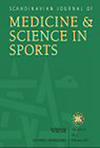Anterior Cruciate Ligament Injuries in Tennis: Injury Mechanism and Return to Sport Rates Following Injury
IF 3.8
2区 医学
Q1 SPORT SCIENCES
引用次数: 0
Abstract
The prevalence and injury mechanism of ACL injuries in tennis are not well documented. This study aimed to report the mechanism of ACL injury in tennis, particularly whether it is linked to specific court positions or movements, and to evaluate how many tennis players return to tennis and to which level. Patients in Denmark diagnosed with ACL rupture from 2000 to 2018, registered in the Danish National Patient Register (DNPR) were asked about injury mechanism. Participants completed an online questionnaire describing court locations and movement preceding the injury. Additionally, patients registered in DNPR with a diagnosis of ACL rupture and tennis as their primary sport were asked about return to sport (RTS) and return to performance (RTP) after their injury. Seventy‐four participants reported sustaining an ACL injury while playing tennis. Lunging, running forward to the net, and movements related to smashing were the most frequent activities leading to injury. A total of 231 patients with an ACL injury identified tennis as their primary sport. Among them, 126 (72%) achieved RTS and 43 (25%) reached RTP. Tegner score significantly decreased among recreational (median from 6 to 4,网球前交叉韧带损伤:损伤机制和损伤后恢复运动率
网球运动中前交叉韧带损伤的发生率和损伤机制还没有很好的文献记载。本研究旨在报道网球运动中前交叉韧带损伤的机制,特别是它是否与特定的场地位置或动作有关,并评估有多少网球运动员重返网球,达到何种水平。2000年至2018年在丹麦国家患者登记处(DNPR)登记的被诊断为ACL破裂的丹麦患者被问及损伤机制。参与者完成了一份在线问卷,描述了受伤前的球场位置和运动情况。此外,在DNPR登记的诊断为ACL断裂并以网球为主要运动的患者在受伤后被问及恢复运动(RTS)和恢复表现(RTP)。74名参与者报告在打网球时发生ACL损伤。冲刺、向前跑向球网,以及与砸球有关的动作是最常见的导致受伤的活动。共有231名前交叉韧带损伤患者将网球确定为他们的主要运动。其中126家(72%)达到RTS, 43家(25%)达到RTP。休闲选手(中位数从6到4,p = 0.014)和锦标赛选手(中位数从7到6,p <;0.001)。治疗类型(手术与非手术)对RTS或RTP没有显著影响。总的来说,前冲,向前跑到网前,或者与扣球有关的受伤是网球前交叉韧带受伤前最常见的动作。大多数(72%)受伤的球员回到了网球场上,而较小比例(25%)的球员实现了康复。
本文章由计算机程序翻译,如有差异,请以英文原文为准。
求助全文
约1分钟内获得全文
求助全文
来源期刊
CiteScore
7.90
自引率
4.90%
发文量
162
审稿时长
3 months
期刊介绍:
The Scandinavian Journal of Medicine & Science in Sports is a multidisciplinary journal published 12 times per year under the auspices of the Scandinavian Foundation of Medicine and Science in Sports.
It aims to publish high quality and impactful articles in the fields of orthopaedics, rehabilitation and sports medicine, exercise physiology and biochemistry, biomechanics and motor control, health and disease relating to sport, exercise and physical activity, as well as on the social and behavioural aspects of sport and exercise.

 求助内容:
求助内容: 应助结果提醒方式:
应助结果提醒方式:


